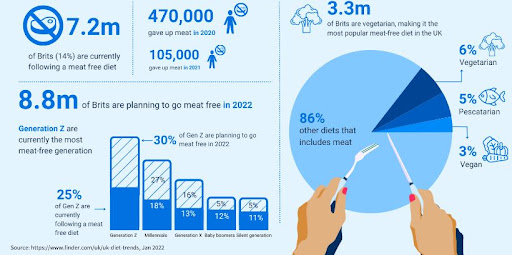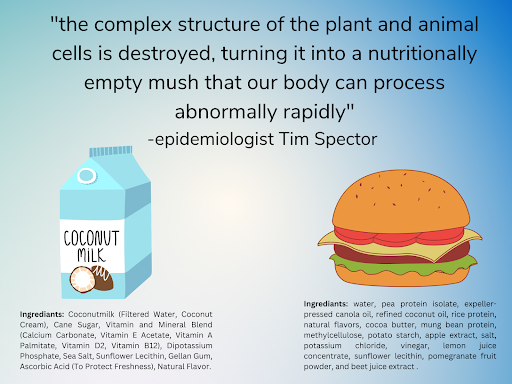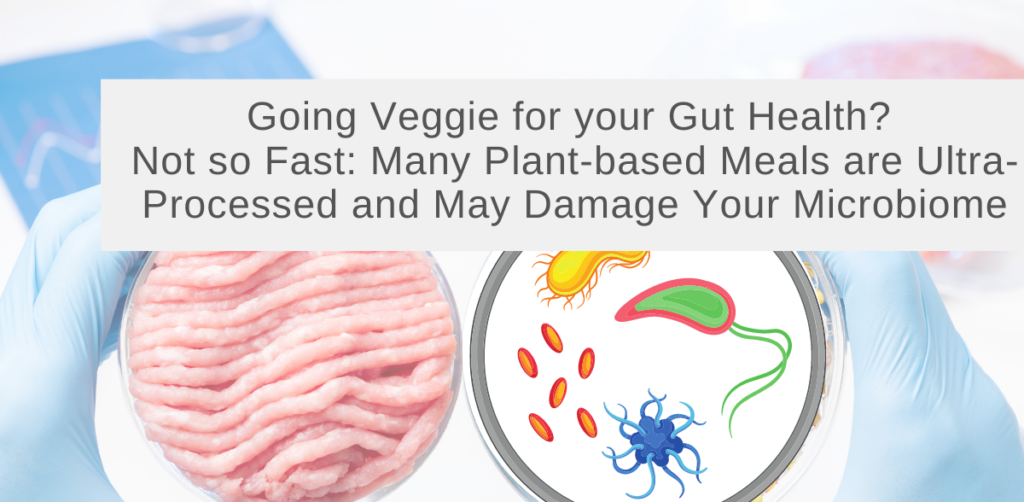Summary:
Plant-based eating has exploded in popularity in the past few years, boasting advantages for individuals’ health as well as the environment. However, the production of ultra-processed plant-based meals has made many microbiome experts caution against blindly following this eating trend. Ultra-processed foods appeared in the market in the early 2000s and have now become well-established risk factors for noncommunicable chronic diseases (NCCD) such as autoimmune diseases, strokes, heart disease, cancer, diabetes, chronic kidney disease, osteoarthritis, and Alzheimer’s disease. In this article we will discuss ultra-processed foods, how the plant-based eating trend has affected UPF consumption, and how this could be impacting your microbiome.
In our publication Systems to model the personalized aspects of microbiome health and gut dysbiosis we briefly touched on how impactful diet can be on your microbial health, and consequently, how diet can contribute to the severity of inflammatory diseases such as IBS, Chron’s, and metabolic disorders. But as more microbiome research is being conducted it is becoming more and more apparent just how intertwined your diet, microbiome, and overall healthspan is.
Recently, plant-based eating has become the newest health trend, with advocates touting how plant-based eating has transformed their overall health; “Eating this way has allowed me to (…) restore my energy (…) I feel so incredible, better than ever really!”, wrote one Food Writer, Ella Mills (Deliciously Ella, 2015). Mills has made plant-based eating her brand, launching a restaurant, numerous cookbooks, and products that are stocked in grocery stores around the UK and EU. Mills is exemplar of the shift in the general public’s perception and consumption of food: nearly 40% of Americans say they make an effort to eat more plant-based, and Britons have reduced meat consumption 17% in the last decade (Lorenzo, 2021; Weston, 2022).

Figure 1. UK diet trend statistics 2022 (Johnson, 2022).
And marketers have noticed: the number of USA food/drink products that used ‘plant-based’ on their labeling increased 287% from 2012-2018 (Varian, 2021). Furthermore, the global vegan meat market is estimated to be valued at $8.3 Billion by 2025 (PR Newswire, 2020).
But what do these plant-based products consist of? Nutritional epidemiologists are raising alarm at the recent plant-based trend, saying that while these products can provide more vegan and vegetarian options, and thus help to cut meat-fueled carbon emissions, many of these products include additives such as texturizers, dyes, and emulsifiers which make them fall under the ‘ultra-processed foods’ classification (Beerman 2021).
“Very little is known about the contribution of ultra-processed plant-based meat and dairy substitutes on nutrition and health
–Dr Benjamin Allès, Nutritional Epidemiology Research Team at Université Sorbonne Paris Nord
Ultra-processed Foods (UPF) have been defined as “foods made by food companies using manufactured ingredients rather than actual foods”, although this description varies – see table 1. (Alexander, 2022). Coined in 2009 by researcher Carlos Monterio, in reaction to the arrival of these products in the early 2000s, the consumption of UPF has increased at a startling rate. Studies have found that ultra-processed foods have become the main source of many countries’ calories: 58% in the USA, and nearly 50% in Canada and the UK (Hall et al., 2019; Heart&Stroke, 2017; Anthony, 2022). And this could be disastrous for a whole generation’s health.
Year | Definition |
2009 | These are made up from group 2 substances (Group 2 is of substances extracted from whole foods) to which either no or relatively small amounts of minimally processed foods (Group 1) are added, plus salt, and other preservatives, and often also cosmetic additives. |
2016 | Formulations of several ingredients that, besides salt, sugar, oils and fats, include food substances not used in culinary preparations, in particular, flavors, colors, sweeteners, emulsifiers, and other additives used to imitate sensorial qualities of unprocessed or minimally processed foods and their culinary preparations or to disguise undesirable qualities of the final product. |
2017 | Industrial formulations typically with 5 or more and usually many ingredients. Besides salt, sugar, oils, and fats, ingredients of ultra-processed foods include food substances not commonly used in culinary preparations, such as hydrolyzed protein, modified starches, and hydrogenated or interesterified oils, and additives whose purpose is to imitate sensorial qualities of unprocessed or minimally processed foods and their culinary preparations or to disguise undesirable qualities of the final product, such as colorants, flavorings, nonsugar sweeteners, emulsifiers, humectants, sequestrants, and firming, bulking, de-foaming, anticaking, and glazing agents. |
Table 1. Evolution of definitions of the term ultra-processed foods 2009-2017, according to the NOVA classification of foods (Gibney, 2019).
Ultra-processed food is known to increase an individual’s risk for noncommunicable chronic diseases (NCCD) such as autoimmune diseases, strokes, heart disease, cancer, diabetes, chronic kidney disease, osteoarthritis, and Alzheimer’s disease. This is thought to be due to the increased inflammation and changes in microbiota composition that is associated with UPFs. While it is still unknown the exact mechanisms behind UPF-associated inflammation, some researchers think that humans’ bodies respond to these food formulations like an invading bacteria, not recognizing it as food [Figure 2].

Figure 2. Examples of the list of ingredients found in common alternative plant-based milk and burger products.
What can be done?
Since UPF make up so much of the Western Diet it is unrealistic to cut them out completely. Particularly, as many of the plant-based products have managed to reach an audience who are not strictly vegan or vegetarian, and thus, have made substantial strides in cutting down on the carbon-emissions emitted due to food production. But, with such high risks of chronic diseases, it is also apparent that we can’t carry on the way we are, so what can be done?
There might be a solution in what can be added instead of what needs to be forgone: Dr Sarah Berry, an expert of cardio-metabolic health, explained that while ground oatmeal triggers an inflammatory response, “if I were to add some red wine or some dark chocolate or other kind of polyphenol-rich food, you actually suppress that inflammation, you counterbalance it” (Anthony, 2022). Therefore, Berry says that a massive improvement could be made by re-formulating Ultra-processed foods, but warns that this would take more research into inflammation, the microbiome, and the mechanisms underlying our guts.
In the meantime, people can help combat their diet-induced inflammation with supplements such as prebiotics, probiotics, post-biotics and synbiotics which have been shown to ease dysbiosis, and restore microbiome health (increased diversity and number of microbes) (Mattewman et al., 2022). These supplement products are flooding the market, but, as we’ve discussed in previous blogs – since the FDA does not currently test these products before they are put on the market, consumers need to be educated on what to look for when buying. In particular, these products need to have conducted research to back up their product claims.
That is where Contract Research Organizations like ours can help. Here at InVivo Biosystems we work with nutraceutical and pharmaceutical companies to determine their compounds’ efficiency, asking whether their formulation improves various health-concerns including gut health, immunity, inflammation, cognitive function, hearth health, muscle strength, and skin health.
References
Anthony, Andrew (2022). Fast food fever: how ultra-processed meals are unhealthier than you think, The Guardian, https://www.theguardian.com/science/2022/oct/16/ultra-processed-food-unhealthier-harder-to-avoid-than-you-thought
PR Newswire (2020). Plant-based Meat Market worth $8.3 billion by 2025 – Exclusive Report by MarketsandMarkets, PR Newswire, https://www.prnewswire.com/news-releases/plant-based-meat-market-worth-8-3-billion-by-2025–exclusive-report-by-marketsandmarkets-301188146.html
Beerman, Kathy (2021). Do plant-based ultra-processed foods improve the nutritional quality of vegetarian diets?, American Society for Nutrition, https://nutrition.org/do-plant-based-ultra-processed-foods-improve-the-nutritional-quality-of-vegetarian-diets/
Weston, Phoebe (2022). How can the UK reduce meat consumption and cut emissions? The Guardian, https://www.theguardian.com/environment/2022/aug/16/how-can-the-uk-reduce-meat-consumption-and-cut-emissions-aoe#:~:text=A%20report%20from%20last%20year,than%20they%20think%20they%20do).
Lorenzo, Daniela (2021). Brits Must Eat Less Meat For The Sake Of Their And The Planet’s Health, Says National Food Strategy, Forbes, https://www.forbes.com/sites/danieladelorenzo/2021/07/15/brits-must-eat-less-meat-for-the-sake-of-their-and-the-planets-health-says-national-food-strategy/?sh=32585f414720
Varian, Ethan (2021). It’s Called ‘Plant-Based,’ Look It Up, The New York Times, https://www.nytimes.com/2019/12/28/style/plant-based-diet.html
Johnson, Georgia-Rose (2022). How many vegetarians and vegans are in the UK? Finder, https://www.finder.com/uk/uk-diet-trends?_ga=2.159763325.1980977180.1566535152-2100258465.1565068082
Alexander, Healthier (2022). What are ultra-processed foods? MD Anderson Cancer Center. https://www.mdanderson.org/cancerwise/what-are-ultra-processed-foods.h00-159538167.html
Gibney, Michael (2019). Ultra-Processed Foods: Definitions and Policy Issues, Current Developments in Nutrition, https://www.ncbi.nlm.nih.gov/pmc/articles/PMC6389637/
Heart & Stroke (2017). News release: Time to curb our appetite for ultra-processed food, Heart & Stroke Canada, https://www.heartandstroke.ca/what-we-do/media-centre/news-releases/time-to-curb-our-appetite-for-ultra-processed-food
Hall et al., 2019, Cell Metabolism 30, 67–77 July 2, 2019 Published by Elsevier Inc. https://doi.org/10.1016/j.cmet.2019.05.008
Matthewman, C., Narin, A., Huston, H., & Hopkins, C. E. (2022). Systems to model the personalized aspects of microbiome health and gut dysbiosis. Molecular aspects of medicine, 101115. Advance online publication. https://doi.org/10.1016/j.mam.2022.101115



